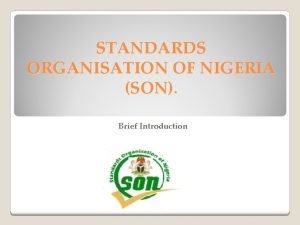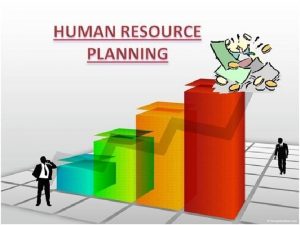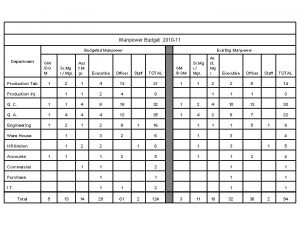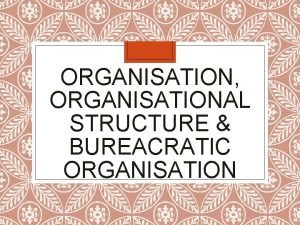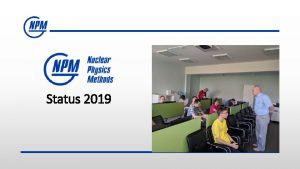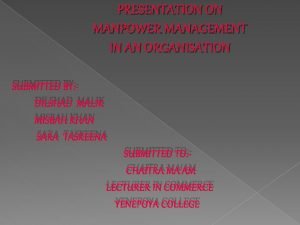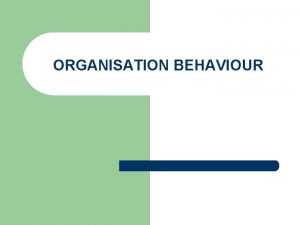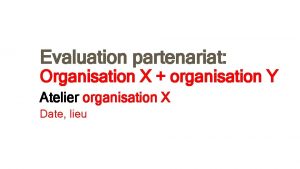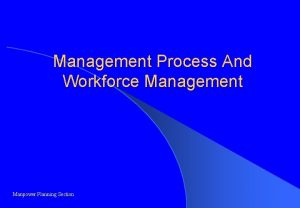LOGO Management of a manpower and the organisation

























- Slides: 25

LOGO Management of a manpower and the organisation of personnel.


Human resources management (HRM) is defined as the process of achieving organizational objectives through the management of people. Tasks associated with HRM include recruiting, hiring, training, developing, and firing employees. When these tasks are done well, pharmacy employees know their responsibilities and receive sufficient feedback to meet them successfully. When these tasks are done poorly, pharmacy employees are given little or inconsistent direction in their tasks and often are frustrated in their jobs.

HRM is critical to the pharmacy profession because many pharmacists and pharmacy employees probably are capable of much higher performance levels than they are providing currently. The negative consequences of this lost performance can be substantial to both pharmacists and their patients.

RECRUITMENT AND PLACEMENT v Recruitment and placement of pharmacy personnel are two of the most important tasks a manager can undertake. If a manager finds and hires competent, self motivated professionals, issues such as motivation and performance are less of a problem. Good hiring practices also diminish employee dissatisfaction and turnover by matching the right person with the right job. v Pharmacy organizations need to exercise great care in recruitment and placement because each employee represents the organization and the profession. All employees who interact with customers help to determine the image they have of your organization. In fact, pharmacy clerks, technicians, and pharmacists are more likely to determine a pharmacy’s image than any advertising or promotional events (Holdford, 2003).

RECRUITMENT AND PLACEMENT v Recruiting consists of all activities associated with attracting qualified candidates to fill job vacancies. The purpose of recruiting is to attract the most qualified candidates to interview for vacant job positions. Recruiting is easier when employers are proactive in their recruitment efforts. Proactive recruitment occurs when employers (1) continually recruit and network, (2) maintain a pleasant work environment where people want to be employed, and (3) establish a positive image in the minds of potential recruits.

RECRUITMENT AND PLACEMENT Negative Consequences Associated v ·With Losing a Pharmacist v ·The pharmacy may have to reduce store hours until a replacement can be found. v ·Patients may go to competitors. v ·The remaining pharmacists and employees have to cover the responsibilities of the missing pharmacist. This can increase employee stress and lead to more overtime costs to the pharmacy. v ·The employer incurs costs to replace the pharmacist. The employer may pay to advertise the position in newspaper want ads or professional journals. Salary costs are spent on personnel involved in related clerical and interviewing tasks. v ·Personnel need to be freed up from normal responsibilities to train newly hired pharmacists.

RECRUITMENT AND PLACEMENT v Proactive recruiting of pharmacy employees should be a continuous activity that takes place regardless of whether a position is open or not. Well-run pharmacies continually develop contacts with potential employees who can be approached once an opening occurs. Contacts can be developed at professional meetings and social gatherings or through work. A pharmacy employer can also cultivate potential employees by hiring pharmacy students for part-time work and mentoring pharmacy students in advanced-practice experiences (i. e. , clerkships). v Proactive recruiters also recognize that it is easier to find candidates the more desirable the job, so they attempt to build a desirable work environment.

RECRUITMENT AND PLACEMENT v Placement refers to candidate application, screening, interviewing, selection, and hiring processes. In many organizations, pharmacists are assisted in this process by corporate personnel offices. Personnel offices offer valuable assistance in advertising positions, managing applications and paperwork, screening candidates, advising about legal and policy questions, checking references, and extending job offers. They free pharmacy personnel to develop criteria for selecting employees, to interview qualified candidates, and to make the final choice.

RECRUITMENT AND PLACEMENT v. Application v. One of the first steps in hiring is for a candidate to fill out a job application. Job applications serve two purposes. The first is to help screen unqualified candidates. v. Applications can identify whether candidates have the necessary training, degrees, and experience for the job. v. The second purpose of applications is to provide background about the candidate for the interview.

RECRUITMENT AND PLACEMENT v Screening v Once they have submitted an application, applicants are screened to see if they meet the requirements of the job. Screening is a process that attempts to weed out unqualified applicants from the pool of potential candidates. Common screening criteria include lack of job qualifications (e. g. , license, degree, residency, or experience), poorly completed applications (e. g. , misspelling, missing information, or sloppy writing), and negative applicant history (e. g. , felony conviction, lying on the application, or frequent changes in employment). v Screening criteria are developed from job analyses.

RECRUITMENT AND PLACEMENT Job analyses attempt to identify some of the following aspects of a job: v[1] Behaviors, tasks, and outcomes required of the employee on the job v[1] Skills, capabilities, and knowledge required v[1] Physical requirements v[1] Required information, technology, and resources v[1] Expected interpersonal relationships v[1] Budget and managerial responsibilities

RECRUITMENT AND PLACEMENT v. Interviewing v. When qualified candidates are identified, interviews are scheduled. Qualified candidates normally are ranked according to desirability, with the top-ranked candidates receiving initial invitations to interview. If a candidate is not chosen from the first round of applicant interviews, a second round is scheduled, drawing from the remaining pool of applicants.

RECRUITMENT AND PLACEMENT v The following is a suggested list of interview preparation steps: v [1] Send information about the position to the candidate. v It is helpful to provide candidates with specific information about the job description and standards for performance to help them prepare for the interview. v [1] Identify interview objectives. It is important to ask your self what you want to achieve with the interviews. For example, if you have acute, immediate needs, you may only consider candidates who are available immediately. However, if your interest is long term, you may be willing to wait for an excellent candidate to graduate from pharmacy school or complete a commitment made to another employer. v [1] Review the position description and performance standards. The position description and performance standards will form the basis of your interview questions. Examples of a position description and performance standards are provided in Table 9 -2. v [1] Develop a list of interview questions. Pay particular attention to assessing the requirements of the job specified in the performance standards. v [1] Study the applications and resumes. Look for accomplishments and credentials on which you want the candidate to expand. Also note frequent job changes, gaps in employment, demotions, inconsistencies in history, or incomplete information on references about which you want to learn more. v [1] Schedule a quiet, uninterrupted interview. It shows disrespect to the candidate if you permit interruptions and distractions from giving your full attention to the interview. v [1] Alert co workers whom you want the candidate to meet so that they can schedule a time to meet.


RECRUITMENT AND PLACEMENT v Selecting Candidates v During the interview process, it is important to keep good notes about each candidate. This is essential for keeping details about candidates organized and for v documenting the selection process in case any claims of discrimination should occur. It is better to save note taking until immediately after the interview to avoid distracting the candidate during the interview. It is also helpful to develop an interview checklist to structure interview notes. Table 9 -3 lists several interview mistakes candidates make frequently that can exclude the m immediately from further consideration (Medley, 1984).

RECRUITMENT AND PLACEMENT

RECRUITMENT AND PLACEMENT v The final choice of the interviewer often comes down to how well a candidate can address the following questions: v [1] Can this person do the basic job? This addresses the ability of the candidate to contribute to the organization’s performance. For instance, a good clinical pharmacist who has little dispensing experience may not be chosen for a position in a community pharmacy setting. Although good clinical skills may be helpful in a community position, basic dispensing capabilities are essential. v [1] How well do the candidate’s skills and capabilities mesh with the organization’s needs? Sometimes the best employee for a position does not have the greatest credentials or the most talent. In many circumstances, the best employee is the one who can fill skill defi ciencies in the organization and complement the talents of other employees. v [1] Will the candidate make my job easier? Everyone has some selfinterest in the selection of a candidate. Successful applicants often highlight how they will be able to solve problems of individuals and the organization. v [1] Would I want to work with this person? This question deals with the rapport between the applicant and the interviewer. If the rapport is good, the chances of selection are enhanced significantly.

RECRUITMENT AND PLACEMENT v Hiring v In most cases, a candidate cannot be hired until the personnel department completes a reference check. If everything is found to be acceptable, a compensation package is put together, and an offer is extended. Once again, it is important that the pharmacy department be involved in the process to ensure that an offer is not mishandled. For example, if an uncompetitive compensation package is put together for the candidate, pharmacy personnel may need to argue for a better one. Once an applicant accepts a position, the hard part of HRM begins. v Hiring is just the first step in the HRM process.

TRAINING AND DEVELOPMENT v A manager’s job is to help staff members succeed at their jobs. One key task in employee success is training. The purpose of training is to help employees meet the changing demands of their jobs. Training benefits both the organization and the employee. For the organization, it improves the quality and quantity of work provided by each employee. For the employee, it can make the job more interesting and meaningful and lead to greater morale and sense of accomplishment (Hold-ford, 2003). Excellent pharmacy service organizations invest in the training and development of their employees.

TRAINING AND DEVELOPMENT

TRAINING AND DEVELOPMENT Training comes in two primary forms: orientation and job training. The purpose of orientation training is to welcome new employees, present a positive first impression, provide information that will permit them to settle into their new responsibilities, and establish early expectations of performance and behavior (Umiker, 1998). It also involves familiarizing new hires with the company’s department’s mission, goals, cultural norms, and expectations. Examples of things covered in orientation training include co worker introductions, a tour of the facilities, discussion of employee benefits, review of departmental policies and procedures, discussion of performance objectives for the job, description of behavioral expectations, demonstration of the computer system, and special organizational training (e. g. , HIPAA, sexual harassment, and discrimination). It is a good idea to develop a checklist that covers all orientation topics to ensure that nothing is overlooked.

TRAINING AND DEVELOPMENT Pharmacy organizations formally or informally may employ a type of training called job rotation (also known as cross -training). Job rotation is designed to give an individual broad experience through exposure to different areas of the organization. In a hospital pharmacy, for example, newly hired technicians can be trained in filling carts, outpatient dispensing, intravenous admixture preparation, inventory management, billing and crediting, and working in one or more satellite pharmacy units. Such training would diversify technicians’ skills, allowing them to work in any number of areas should one be short -staffed, and may help to improve their self-esteem and sense of contribution to the organization.

TRAINING AND DEVELOPMENT v. Development requires a long-term focus by preparing for future needs of the individual or organization. Professional development typically consists of answering the following questions: (1) what is my present situation? (2) Where do I want to be? (3) What skills, knowledge, and training do I need to get where I want to be? v. Development differs from training in that it requires a greater intensity of education and instruction.

THANK YOU FOR ATTENTION!!!
 Son logo nigeria
Son logo nigeria Ajeets management & manpower consultancy
Ajeets management & manpower consultancy Financial management is indispensable in any organisation
Financial management is indispensable in any organisation Manpower strengths and weaknesses
Manpower strengths and weaknesses Define manpower planning
Define manpower planning Manpower planning definition and importance
Manpower planning definition and importance Hát kết hợp bộ gõ cơ thể
Hát kết hợp bộ gõ cơ thể Bổ thể
Bổ thể Tỉ lệ cơ thể trẻ em
Tỉ lệ cơ thể trẻ em Gấu đi như thế nào
Gấu đi như thế nào Tư thế worm breton
Tư thế worm breton Hát lên người ơi
Hát lên người ơi Kể tên các môn thể thao
Kể tên các môn thể thao Thế nào là hệ số cao nhất
Thế nào là hệ số cao nhất Các châu lục và đại dương trên thế giới
Các châu lục và đại dương trên thế giới Cong thức tính động năng
Cong thức tính động năng Trời xanh đây là của chúng ta thể thơ
Trời xanh đây là của chúng ta thể thơ Mật thư anh em như thể tay chân
Mật thư anh em như thể tay chân 101012 bằng
101012 bằng độ dài liên kết
độ dài liên kết Các châu lục và đại dương trên thế giới
Các châu lục và đại dương trên thế giới Thể thơ truyền thống
Thể thơ truyền thống Quá trình desamine hóa có thể tạo ra
Quá trình desamine hóa có thể tạo ra Một số thể thơ truyền thống
Một số thể thơ truyền thống Cái miệng xinh xinh thế chỉ nói điều hay thôi
Cái miệng xinh xinh thế chỉ nói điều hay thôi
